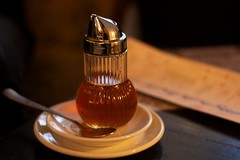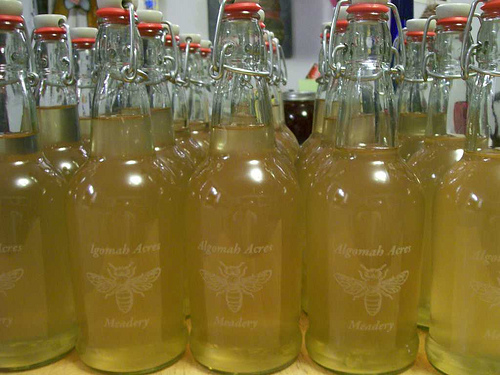I’ve been brewing cider for so long that I’ve begun to get lazy. It is still delicious, so I am going to share my lazy method with you.
Category Archives: Food and Drink
Brewing Cider (Vegan, unless you use honey)
First off, let me assure you that yeast are a unicellular fungi. They are as vegan as eating a mushroom. Iíve been getting a couple of notes that yeast is not vegan and I just wanted to clarify that yes, it truly is. Honey is not vegan. I know. That is why I have the note at the top of the page. Some beers are vegan, too, but some include fish bladder (like Guiness), so if you are looking to booze it up without possibly eating any bits of animals, making your own booze is the way to go!
Everything you need to make your own cider:
Bare Essentials:
- Juice – any kind will make a cider as long as it has sugars in it, doesnít have any fancy preservatives in it, and isnít too acidic.
- Yeast – any kind will ferment the juice, but some are better than others. You need at least a half a tablespoon, but more than a tablespoon is just wasting it.
- Something to ferment in – this means a glass carboy or a food grade plastic bucket that can be airtight when stoppered – usually 5 gallons is status quo for brewing, but it is up to you.
- Fermentation Lock and Drilled Stopper – These are pretty cheap and you can reuse them practically forever.
- *Bottles – (10 bottles for each gallon) pop off top bottles are easiest to rebottle. You can reuse them over and over and over after sanitizing.
- *Bottling Crowns – Bottle caps for pop-off top bottles are cheap. A couple of bucks should get you enough for 10 or 15 gallons of cider.
- *Capper – I suggest an Emily Capper – they are less than fifteen bucks and easy to use.
- Tubing – you need something to get the cider out of the fermenter and into the bottles, right?
*You can get away with either using any old bottle with a lid, really, but make sure it is sanitized, sturdy enough to handle some pressure, and air tight.

Continue reading Brewing Cider (Vegan, unless you use honey)
Why Hershey Has Made Me SadÖ Again.
Some people may not realize that Cadbury Creme Eggs in the United States are not from the UK based Cadbury. They are from Hershey. They have been since they were mass introduced to the United States. Hershey bought the rights from Cadbury for exclusive production and distribution in the U.S., so they make the rules here. The original recipe for the Cadbury Creme Egg started with:
Milk Chocolate (Sugar, Milk, Cocoa Butter, Chocolate, Soya Lecithin, Vanilla), Sugar, Corn Syrup, Egg Whites, Artificial Coloring, Vanilla.
Sounds good, right? It included plenty of fat, sugar, and happiness. Specifically, the happiness it contained consisted of 176 calories, 7 grams of fat (4 of it saturated), 29 grams carbohydrates (26 of that being sugar), and 2 grams of protein. The grand total of its parts came to 40 sturdy grams in weight and immeasurable amounts of deliciousness.
6 Noteworthy Myths and Facts About Baking Soda (Sodium Bicarbonate)
Arm and Hammer corner the market on this simple little powder, originally popularized to simply leaven breads using chemicals instead of biological enzymes (yeasts). How Arm and Hammer got their simple alkaline salt into all kinds of other markets since the late 80ís is incredible. It is touted as many things, but how many of these things are stretches, and how many of them are actually practical? Some of the proposed uses Iím going over are pretty good and some of them are just ridiculous.
Nontoxic Deodorizing: One of the most common alternative uses for baking soda is using it for a deodorizer in your refrigerator, pantry, or closet.
Weak win
Baking soda has mild odor absorbing qualities. It can be slightly effective at absorbing simple alkaline and oil odors and neutralizing acidic odors over a (very) long period of time. The first problem is that sodium bicarbonate is an extremely mild alkali so it wonít pack much of a punch fighting acid based odors and this same mildness prevents it from quickly absorbing alkaline odors. The second problem is that once the exposed area is saturated, it doesnít work any more. The third problem is that it has little to no effect on complex odors and those are the most problematic ones. If you have a stinky fridge or cupboard, just take the food out of it and clean the darn thing, baking soda isnít going to cut it.
Sources: http://www.armhammer.com/basics/magic/#4 http://www.newton.dep.anl.gov/askasci/chem00/chem00388.htm Continue reading 6 Noteworthy Myths and Facts About Baking Soda (Sodium Bicarbonate)Brewing Cyser, (Possibly) the Oldest Beverage Recipe on Earth
I thought Iíd bring up an amazing lesser-known brew called cyser. This beverage has ancient origin and can be the most amazing beverage you will ever touch to your tongue. Using the right apples and a good quality honey can create a rich, crisp, even buttery apple flavor that will likely make you regret having to swallow each sip. Cyser is usually produced in very small batches commercially and it is pretty darn hard to find a bottle to buy short of importing it from a small meadery somewhere in Europe. There is actually an eHow article on how to find it and buy it, if you want to skip the brewing and go straight to the tasting, but I donít recommend that when it is so rewarding to make your own Ė not to mention cheaper; Iíve seen $60 32 oz.bottles of the (real) stuff on e-Bay.
The origins of cyser are traced back to the prime days of mead, about 8000 years ago. This was the original apple cider. Thousands of years later, Druids popularized the apple in Europe and the apple brewing Renaissance began, resulting in variety after variety of cider – the main alcoholic beverage of the people until the late 1800ís. Apple orchards actually paid part of their wages in pints of apple cider to their workers. Cyser is beyond apple cider though, and worth the extra effort, I think. Brewing cyser is a reenactment of an ancient tradition.

![]() photo credit: Marco Hamersma
photo credit: Marco Hamersma
Continue reading Brewing Cyser, (Possibly) the Oldest Beverage Recipe on Earth
![Apple_juice_with_3apples[1]](http://eulamue.com/wp-content/uploads/2014/02/Apple_juice_with_3apples1.jpg)
